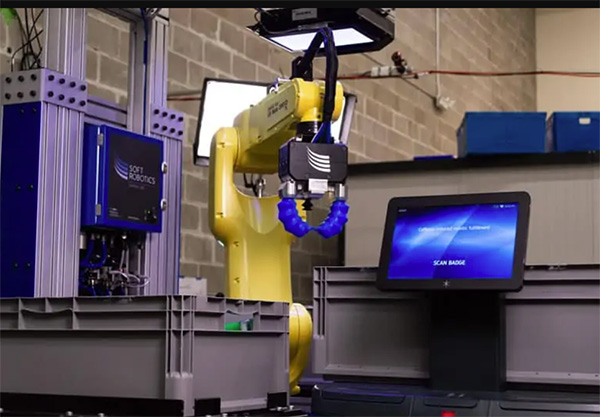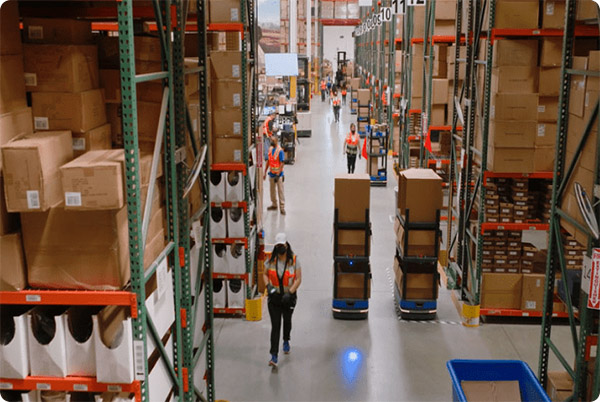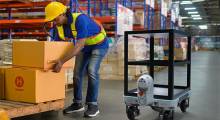Many industry analysts are bullish about the mobile robot market, given the growing demand for labor-saving assistance in warehouses. However, automation vendors are facing challenges from e-commerce shifts, competitive pressures, and the constrained availability of venture capital. Last week's acquisition of 6 River Systems LLC came as a reminder for robotics startups, established suppliers, and their customers that the market is still evolving.
E-commerce provider Shopify Inc. laid off as much as 85% of 6 River Systems' staff prior to selling it to Ocado Group PLC, partly in response to falling customer orders, sources told Robotics 24/7. CEO Tobias Lütke also announced that Shopify was laying off 20% of its total staff and that it was selling Shopify Logistics (formerly Deliverr) to Flexport.
AMR market allegedly growing
Market research firms have been predicting steady growth. The global market for autonomous mobile robots (AMRs) could expand from $2 billion (U.S.) in 2022 to $9 billion by 2032, experiencing a compound annual growth rate (CAGR) of 15%, according to Global Market Insights Inc.
Similarly, Research and Markets predicted that the global AMR market could grow from $3.4 billion in 2023 to $9.5 billion by 2030 at a CAGR of 15.5%. It also said that AMRs could reach 20% of the total warehouse automation market by 2030.
Such estimates range widely, but the consensus among these firms is that labor shortages, the need to increase ergonomics and safety, and consumer expectations of accelerated deliveries have contributed to demand.
At the same time, as much as 75% of warehouses and distribution centers in North America are reportedly not yet automated. More than 60 AMR providers offer to fill that demand, but several analysts told Robotics 24/7 that very few of them are currently profitable.
Consolidation continues
Amazon.com purchased Kiva Systems for $775 million in 2012, reserving its platforms for internal use only and helping to create the category by showing the “art of the possible” and forcing retailers to look for alternatives. Shopify's acquisition of 6 River Systems (6RS) for $450 million in 2019 was one of the largest transactions to date in this space.
More recently, there were several mobile robot mergers and acquisitions (M&A) in 2021. Transactions included Zebra Technologies buying Fetch Robotics for $290 million, ABB Group acquiring ASTI Mobile Robotics Group for $190 million, and Locus Robotics purchasing Waypoint Robotics. In addition, Teradyne merged its Mobile Industrial Robots and AutoGuide Mobile Robots units in 2022.
While there were no reported failures or complete shutdowns of AMR providers in the past year, many reduced their workforces, as e-commerce growth slowed because the COVID-19 pandemic abated. Examples included Seegrid and IAM Robotics.

Experts react to 6 River Systems news
Robotics 24/7 asked the following experts about their thoughts on 6 River Systems changing hands and trends in the wider mobile robotics market.
- Fady Saad, general partner, Cybernetix Ventures
- Ash Sharma, managing director, Interact Analysis
- Oliver Mitchell, partner, ff Venture Capital
Did this come as a surprise to you? If not, why not?
Saad: In a sense, yes, but M&A in the space is not surprising at all, and we should actually expect more of that in the coming 12 to 18 months.
Sharma: Partly. What’s not surprising is that a mobile robot company has been acquired. I was asked about the vendor base a lot at ProMat, and I’ve been saying that acquisitions will come mostly from external companies – like major retailers, automation integrators, and big tech companies.
What was somewhat surprising was Shopify’s decision to offload 6RS, but this is clearly a wider cost-cutting exercise that its going through. My opinion was that 6RS was struggling a little within the Shopify family and not showing the growth the parent was hoping for.
The mobile robot market grew quickly into the pandemic, but what are its prospects now that e-commerce growth has slowed or even reversed?

Saad: E-commerce might have slowed because of economic reasons, but the way consumers purchase and expect their orders to be delivered quickly would never change. The only way to meet these expectations is by robotics, automation, and AI, which will continue to be the key technologies in e-commerce.
Sharma: Remarkably positive. We actually issued our latest forecast update to clients last week, and our forecast—which was already very positive—has increased even further.
Despite the fall back in e-commerce, what we’re seeing is a continued investment to offset labor shortages, as well as 3PLs [third-party logistics providers] going full steam ahead with their automation plans.
As venture capital becomes more scarce or harder to get, what should robotics businesses do to demonstrate their value, both to investors and customers?
Mitchell: Generally, I think that robotic companies—and all startups—will need to focus on cash management first and foremost, as financings will now take longer. This means tempering new product-development plans with an invigorated sales effort.
Once a startup has consistent and meaningful recurring revenue streams, many things will then open up to them, including up or equity rounds and non-dilutive venture debt. The inverse is shuttering or selling assets too early at a steep discount.
Saad: Going back to the business fundamentals: target large markets, solve real problems, [and offer] highly optimized and impactful products.
[Robotics companies also need] disciplined cost and cash controls, solid unit economics, and a lot of determination and perseverance.

Sharma: We’re now getting to a stage where proving the technology works has already been done, and instead what interested parties want to see is how vendors differentiate themselves and how the move beyond simple robot companies to full-fledged solution providers.
How much of the recent consolidation, strategic partnerships, and layoffs is because of immature technology, weak business models, or overextending staffs?
Saad: Some are related to all what you mentioned, but some are also natural turnover, becoming more lean, changing needs and priorities, and definitely macro conditions.
Sharma: An alternative point of view is that the mobile robot industry has not consolidated at all.
Yes, there have been acquisitions, but if you look at the concentration of revenues, it is actually dispersing amongst more vendors. And if you look at the number of mobile robot vendors, it continues to grow year on year.
What are you looking for right now in robotics startups?
Saad: A focus on the business fundamentals.

Mitchell: At ff Venture Capital, we are looking for seed-stage, robot-enabling businesses with high margins and early sales traction. We like visionary founders that are disrupting big markets with mechatronics.
Ultimately, we see hardware as a vector for software that scales quickly.
What should robotics end users do to mitigate their risk?
Saad: For critical technologies, seriously consider acquisitions.
For important technologies, quickly develop partnerships with at least two providers.
For good-to-have technologies, keep an eye out and continue scouting.
About the Author
Follow Robotics 24/7 on Linkedin
Article topics
Email Sign Up




















